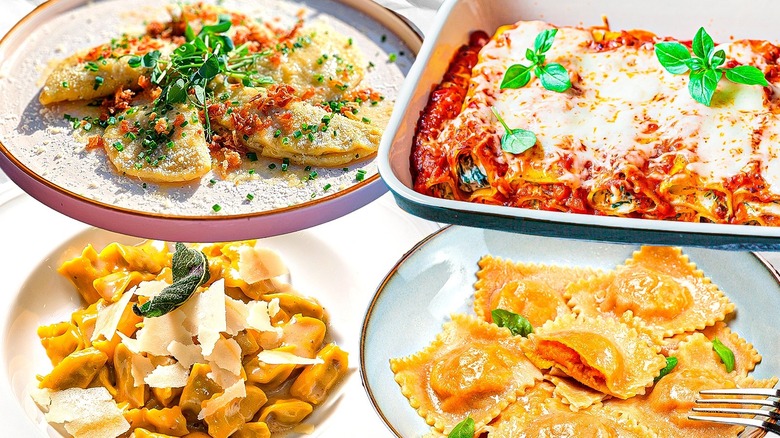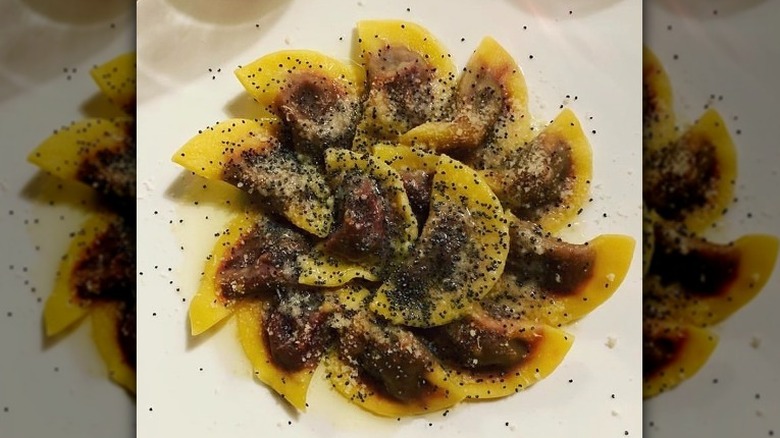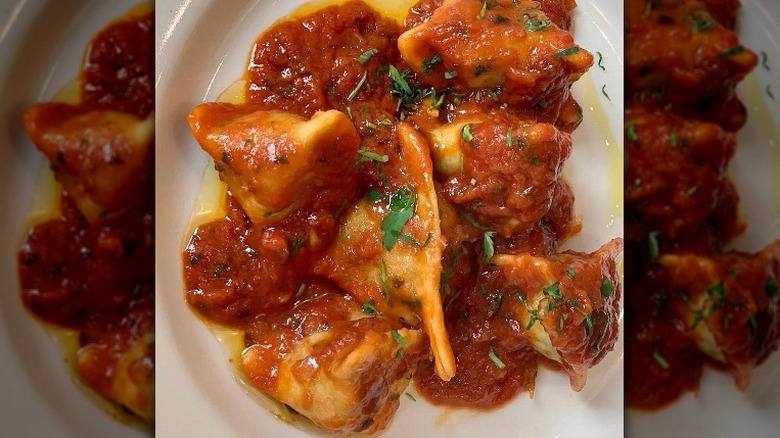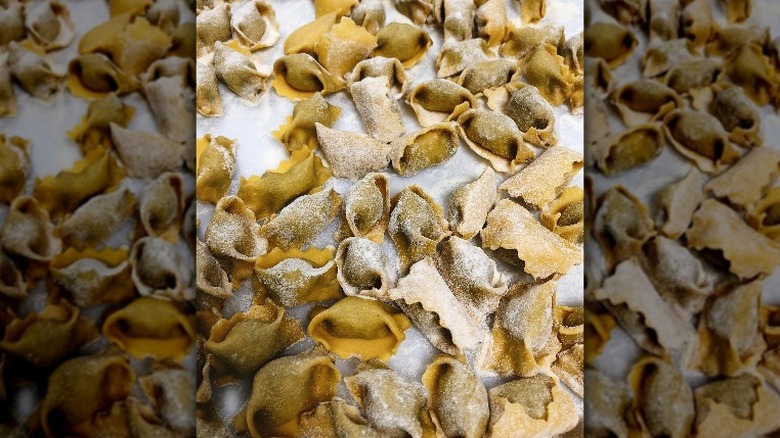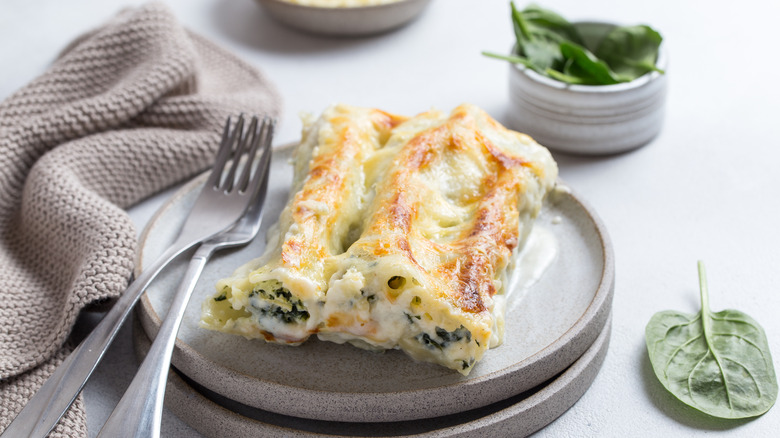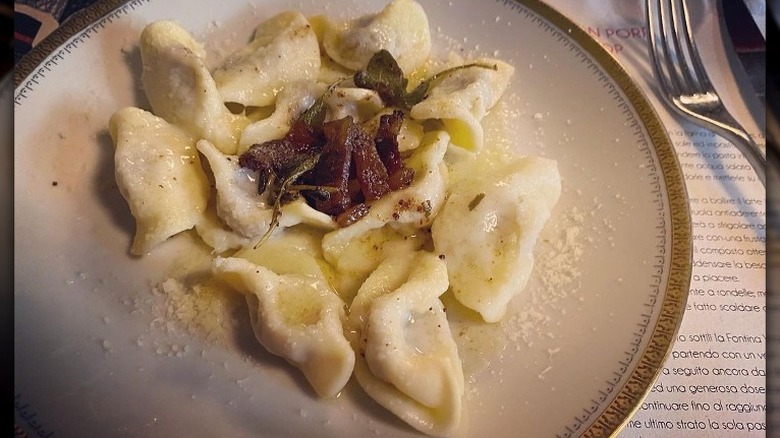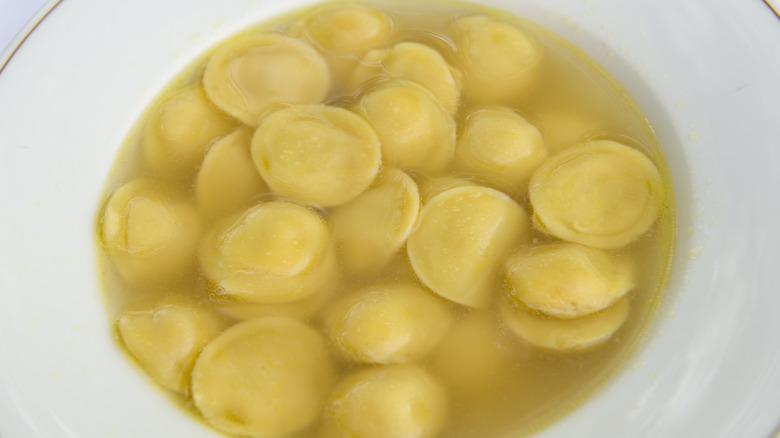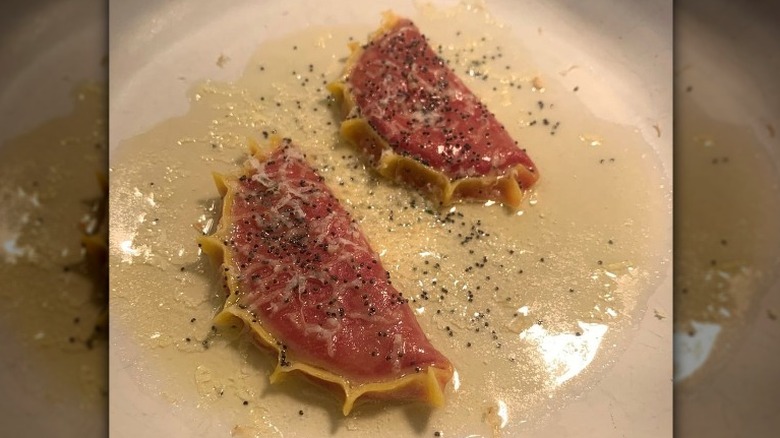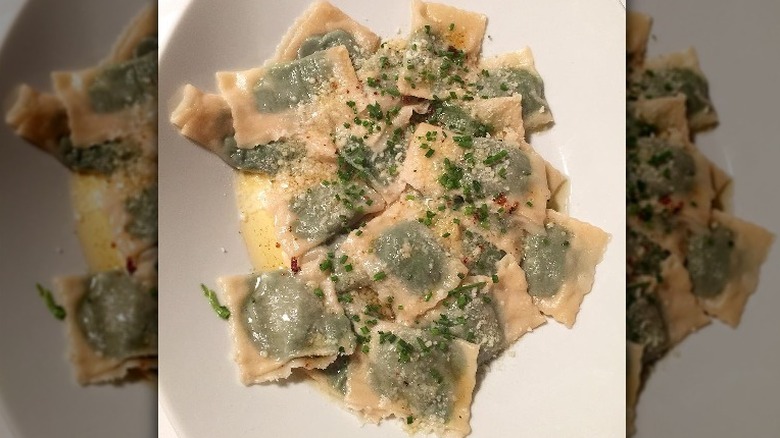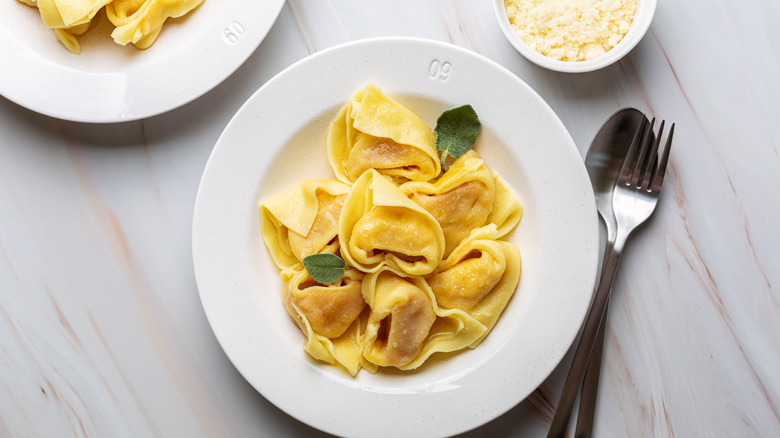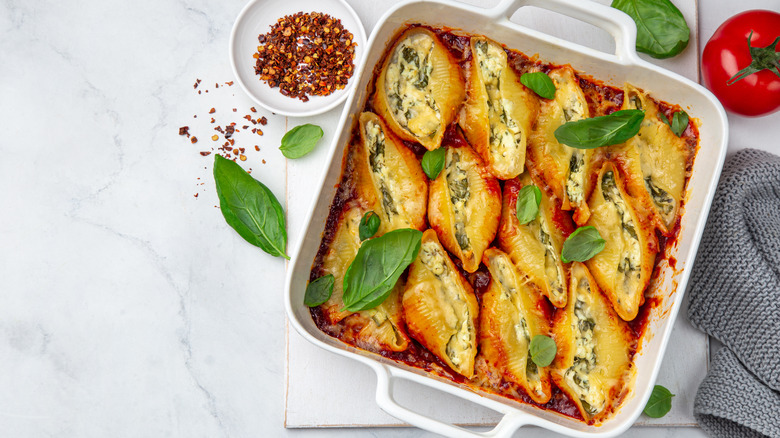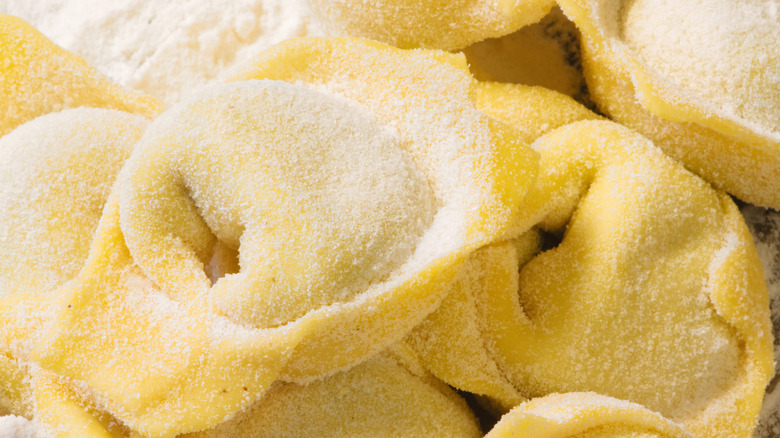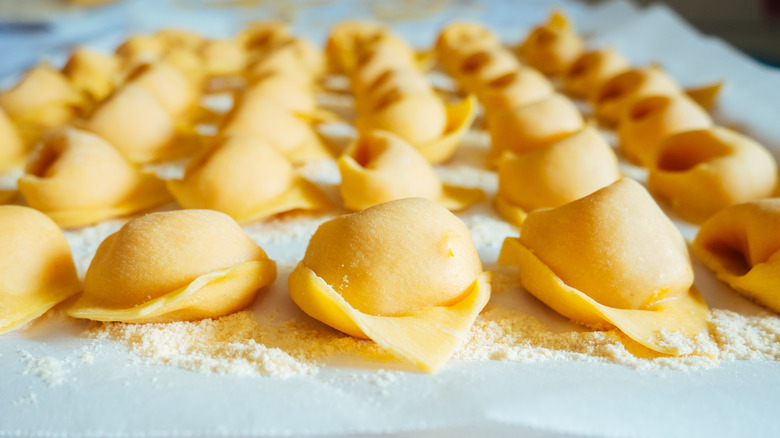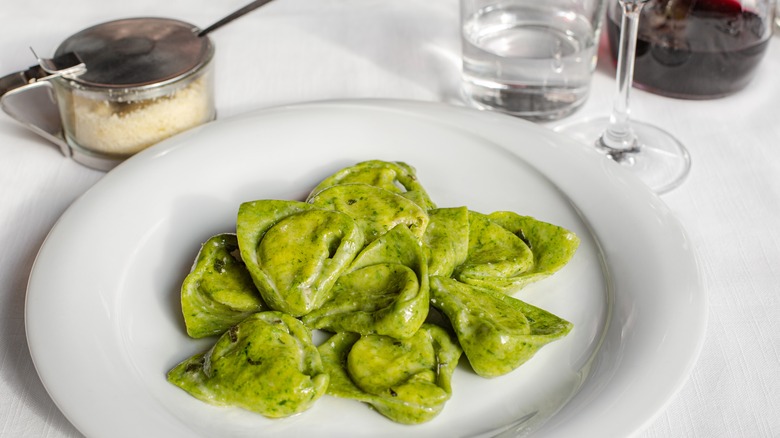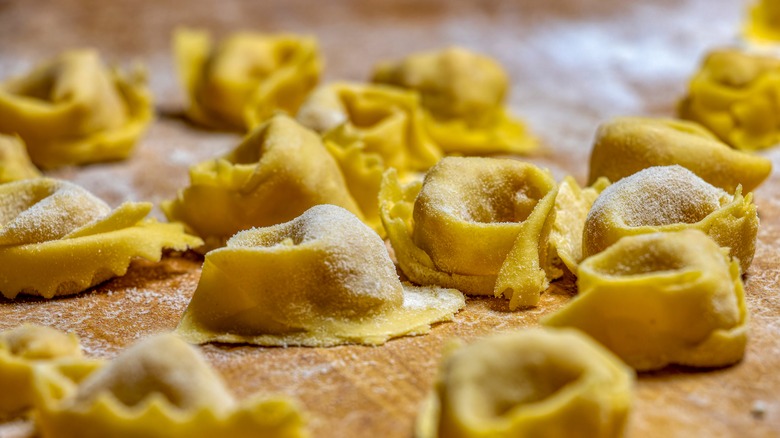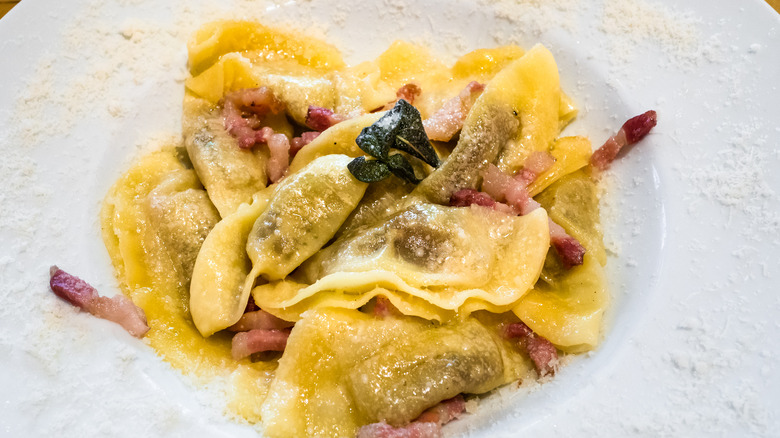16 Stuffed Pasta Dishes You Should Know About
Pasta is one of the most beloved ingredients worldwide, but especially in its country of origin, Italy. You can travel throughout the regions and find many different pasta dishes with geographically significant ingredients, including local seafood, meats, and cheeses. And although the recipe and shape of the pasta vary depending on the preparation, it is the delicious common denominator that unites dishes across the country.
Pasta can be served in many different ways. While many types of pasta can be sliced or rolled into the desired shape and covered with a complementary sauce, there is notable artistry attached to stuffed pasta dishes. The pastaio (pasta maker) must ensure the pasta is robust enough to survive the shaping and filling process, but it also must perfect a filling and a sauce that bring out the best in one another. Here are some of the most diverse stuffed pasta dishes you'll find in Italy.
Casunziei all'ampezzana
Casunziei all'ampezzana is a popular pasta dish in the mountainous region of Veneto in Northern Italy. Its more exact origin is Cortina d'Ampezzo: a town in the southern (Dolomitic) Alps mountain range.
This pasta is easily identified by its unique, colorful ingredients. Its filling is made with roasted beetroot and ricotta cheese, which gives the pasta's interior a bright pink hue. Some preparations of the pasta filling also include potatoes or yellow turnips to help bulk it up. It may also be seasoned with nutmeg or cinnamon, which complements the mild sweetness of the beets. The shape of the pasta (casunziei) is in a half-moon, rolled thin, to allow the color of the filling to poke through. Casunziei all'ampezzana is typically served with butter, Parmesan, and poppy seed sauce, which allows the flavor of the pasta to shine. Some preparations will also include fresh sage leaves for a vegetal element.
Zembi d'Arzillo
Zembi d'Arzillo is a fishy ravioli found on the Ligurian coast. The pasta might have etymological connections to the Arabic word "zembil," a basket used to transport fish. This connection isn't entirely surprising, since trade routes have long existed along the Italian Riveria. The Genoese word "arzillo" refers to the smell of seaweed growing near the coast — which is often deemed "the perfume of the sea."
The most common fillings for this pasta include flavorful white-fleshed species (pesce di scoglio) like rockfish, escarole, and borage. The fish is first cooked with garlic and accented with herbs like marjoram and parsley. Then, the egg pasta dough is stuffed into squares or rounds. To avoid upstaging the fish flavor, this pasta is often served with a light tomato and basil sauce or a fish sauce made with fish bones, clams, cherry tomatoes, and herbs. It is a very light dish compared to some of the heavier Italian pasta made with bolognese or ragù.
Ravioli del plin
Ravioli del plin is found in the Langhe and Moneferrato regions in the Italian Piedmont. The "plin" refers to the pinching technique used to seal the ravioli together. Ravioli del plin can also be made with agnolotti pasta, which is much more tedious to make and shape because of its small size. Italian families tend to reserve this dish for special occasions or osterie (Italian restaurants).
Ravioli del plin, unlike other regional pasta dishes, does not have a singular filling. The pasta can be made vegetarian with a vegetable-based filling of cabbage, rice, or leftover meat. Instead, the dish's main defining feature is the shape of the pasta — which should never exceed the size of a thumbnail. It is also rolled very thin so that the filling is evident and forward in the final presentation. The dish's sauce depends on the stuffing ingredients and ranges from a straightforward, meat-based gravy to a simple butter sauce.
Culurgiones
Culurgiones are a staple of Sardinian cuisine originating in Ogliastra, a rural town on the Eastern side of the region. These pastas have a lot in common with pierogi because both are stuffed with a potato filling. However, the inside of this pasta gets a bright flavor from pecorino cheese and mint. The sauce used for this pasta varies and can include a simple tomato sauce or brown butter sauce accented with more mint and cheese. Many families in Sardinia also have other variations on the pasta, including one from Seui, in which the pasta is filled with a salty brined cheese called cas'e fitta, which resembles a Greek feta.
Culurgiones are especially unique because it is supposed to be shaped like a wheat spike with a folded top. A small dollop of filling is added to the center to shape this pasta before being meticulously pinched like a taco and sealed shut.
Cannelloni ricotta e spinaci
Cannelloni ricotta e spinaci is a long tubular pasta stuffed with ricotta and spinach. The preparation for this pasta variety is relatively simple compared to other stuffed pasta. Parboiled egg pasta sheets are cut into squares and lined with vegetarian filling, nutmeg, and Parmesan. Then, the pasta is rolled into a log and placed in a tomato-sauce-lined pan. This saucing step is critical to prevent the pasta from sticking to the bottom. Other pasta preparations make a béchamel sauce with small pockets of tomato sauce. Lastly, the dish is finished with a layer of sauce before being baked until bubbly.
Although the cannelloni shape originated in the Campania region of Italy, the pasta shape has spread in popularity throughout the region. Some dish preparations utilize lasagna sheets, while others take the shortcut with cannelloni tubes. Cannelloni can also be made with meat (cannelloni de carne), like beef and pork, and served with a hearty ragù sauce.
Scàrpinocc de Pàrr
Scarpinòcc de Par is a well-loved pasta in the Bergamo region of Italy. The pasta shape was named after scarpe; an artisan cloth shoe found in the village of Parre. The shepherds who originally wore the shoes call the pasta "betoi," meaning "donkey ears." To shape the pasta, it is cut into a half-moon, pinched on the sides, and indented in the middle to resemble candy. This provides a lot of nooks and crannies for the sauce to stick to.
Scàrpinocc de Pàrr is filled with a simple filling of Parmesan cheese, garlic, breadcrumbs, and spices like coriander, anise seed, cinnamon, and nutmeg. It differs from the casoncelli because the latter is made with a meat-based filling, while the Scàrpinocc de Pàrr is strictly vegetarian. This pasta shape is light yellow because of its fillings, which are complemented by adding a sage butter sauce topped with a generous portion of cheese.
Anolini
Anolini are a small, filled pasta endemic to the Emilia-Romagna region. The dish is exclusively made with stewed beef and served with a meaty sauce made by cooking down capon (tender chicken) and beef. In Piacenza, you'll find a smaller version of anolini made with meat and mushroom ragù.
Because of the time it takes to prepare the meat broth, anolini is often reserved for special occasions and holidays. The stewed beef and wine filling is cooked between 16 and 36 hours, which creates a succulent filling filled with flavor. Once the filling is finished cooking, it is spooned between two pieces of pasta dough and cut with a serrated or round pasta cutter. The cutter is important because it seals the edges of the pasta together and prevents it from opening when the pasta is boiled. Once the pasta finishes cooking, it's served with broth and garnish of Parmigiano cheese.
Cjarsons
Cjarsons, otherwise known as cjalzons or cjalsonos, are from Friuli. Its shape bears some similarities between the agnolotti and a half-moon ravioli, but the cjarsons can also be made into other round or boat-like shapes. There is also immense variation in the pasta within the Friuli region itself. The plains region uses meat in their cjarsons, while the mountainous region sticks to the vegetarian version.
The dough of this pasta is unlike other types of pasta dough because it historically omits eggs. Instead, the pasta is made with just flour and water, or occasionally potatoes — similar to a gnocchi dough. While the fillings vary based on geography, there is often some mixture of sweet and savory ingredients, including raisins, chocolate, chives, herbs, and pine nuts. Unsurprisingly, this pasta dish earned the title of svuota-dispensa — a pantry emptier — via Fruilian homemakers. The most common sauce for the pasta is melted butter and smoked ricotta, which complements the wide variety of fillings possible.
Schlutzkrapfen
Schlutzkrapfen is a type of pasta lumped into the same category as the half-moon ravioli known as mezzelune. This regionally-specific pasta is often found in the Northern Italian region of Trentino-Alto Adige, where it is filled with spinach, potato, and ricotta. After the thin sheets of pasta are stuffed, they are boiled until al dente and topped with a brown butter sauce. Typically, the schlutzkrapfen is served with a garnish of Grana Padano cheese, which complements the nutty sauce and cheesy filling.
The name of this pasta dish has German origins. It's derived from the word "schlu(t)zen" meaning "to slide." This refers to the pasta sliding around in the butter sauce and eventually into the eater's mouth. In the South Tyrol region of Alto Adige, the pasta is made with a mixture of rye and wheat flour, filled with curd cheese (quark), and is often served as a starter or a main course on the table.
Tortelli di zucca
Tortelli di zucca is an autumnal pasta dish from Lombardy. The main filling for one variation, tortelli mantovani, is pumpkin — often a local yellow-fleshed variety called zucca mantovana. Besides the pumpkin, the tortelli are filled with crumbled amaretti biscuits, grated cheese, and an apple preserve called mostarda. Hard amaretti biscuits act as a sponge to help soak up the extra moisture while providing a mild almond undertone to the pasta. Mostarda, which is made with fruit like apples, pears, or quince, and a zesty mustard blend, adds an outstanding organic fruity flavor to break up the dense pumpkin. The most common sauce for this sweet-and-savory pasta dish is mild sage butter with a crushed biscuit garnish.
The go-to dough for this pasta is egg-based. It can be shaped into the traditional tortello or into a square ravioli. Some variations of the pasta use butternut squash instead of the pumpkin, too.
Conchiglioni ripieni al forno
You have likely already had conchiglioni ripieni al forno — you just may have heard it by its other name. Baked stuffed shells got their start in Sicily before migrating to the United States. The stuffed shells can be filled with various fillings and sauces; the most common Sicilian preparation is made with a veal-based meat sauce with peas and tomato sauce. Alternatively, stuffed shells can also be made with a béchamel sauce instead of tomato sauce.
The key ingredient to making stuffed shells is pasta. Conchiglioni pasta is marketed as jumbo shells in the United States and also comes in smaller varieties: conchigliette (small) and conchiglie (medium). The jumbo shells are the easiest to stuff, thus making them the most popular pairing for this recipe. The dried shells are boiled until al dente before being stuffed, sauced, and baked with a cheese and herb garnish.
Pansoti
Pansoti (or "pansotti") is derived from the Italian word "pancia" — which translates to "pot belly." This pasta can be made in different shapes, including ravioli-like triangles or half-moon shapes, but consistently features a tiny "belly" made with vegetarian fillings. The Pansotti is Northern Italy's choice for filled pasta, specifically in the Liguria region.
The first written reference to the pasta dish was pansoti cu a salsa nuge ("panotti with a walnut sauce"), from Rapallo. Most pansoti varieties are filled with soft, creamy ricotta cheese and preboggion. Preboggion is a term that encapsulates several types of wild greens, like radicchio, Swiss chard, dandelion greens, borage, wild fennel, and nettles, combined together. If these greens aren't available, spinach and parsley can be substituted. The greens and cheese are seasoned with marjoram, nutmeg, and cheese and promptly stuffed into the pasta dough. The defining characteristic of pansoti is the walnut sauce it's served in. It's made by blending walnuts, pine nuts, milk, garlic, soaked bread, Parmigiano, marjoram, and olive oil together into a thick sauce.
Cappellacci di zucca
Cappellacci di zucca is beloved in the city of Ferrara. This dish traces its roots as far back as the Renaissance and was featured in a recipe as early as 1584. The cappellacci pasta shape was named after the hats peasants wore and often have different designs based on the person making them. Some of the pasta has fluted edges instead of straight, while others have their tails tucked up into the folds rather than hanging down. The primary difference between the cappellacci and tortellini (or tortelloni), though, is that the cappellacci always starts out as square pasta sheets while the tortellini is round.
Its filling can be made with sweet violina pumpkins, roasted with salt, and spiced with nutmeg. This type of squash is the same as butternut squash, so the two are often interchangeably used in recipes. The pasta is served with either a butter sauce or a tomato ragù.
Balanzoni
The most distinct part of the balanzoni is its green color. This pasta is stuffed with creamy and cheesy goodness of ricotta, mortadella, and Parmigiano. Although some recipes incorporate spinach into the filling, the most traditional way is to stick to the dough because the flavor of the spinach would easily overpower the delicate cheeses. It would also disrupt the color contrast between the green pasta and the white filling. To ensure that the pasta is the star of the show, this pasta dish is typically only served with a sage butter sauce and a side of Parmesan cheese.
The likely origin story for this recipe dates back to the 1980s and 1990s when a pasta maker used leftover cheeses and spinach-based pasta dough. The pasta maker wanted the name to represent Bologna, so it was decided to name the dish Dottor Balanzone after the Carnival mask of the city.
Marubini
Marubini is a meat-stuffed pasta originating from the Cremona region of Lombardy. It's similar to cappelletti in Northern Italy but instead is stuffed with a medley of beef, veal, and pork seasoned with nutmeg, carrots, onions, red wine, occasionally chicken liver, and cheese. The exact ratio of the ingredients in the pasta depends on the family making it. But, the predominant ingredient that makes marubini different from other types of filled pasta is salami, which adds an unexpected salty and fatty element.
This dish's broth is unique, too, because it's made by cooking three kinds of meat, chicken, beef, and pork (salami), separately before bringing it all back together and tossing the pasta in it. The broth may also be made with veal, which is less common than the standard trio. Some versions of the recipe also stick to serving the pasta in butter seasoned with sage instead of opting for the broth entirely.
Casoncelli alla Bergamasca
Casoncelli alla Bergamasca originated in Bergamo as far back as 1366. Over many years, casconcelli alla Bergmasca became an important dish signifying honor and distinction and was popularized at regional festivals.
It is believed that the name of this dish was derived from the Italian word "caseus" (cheese) or "calzoncino," which is found in some recipes requiring a horseshoe-shaped pasta. Not all versions of casconcelli alla Bergmasca are this shape, though, some are half-moons while others are candy or handkerchief-shaped. The most common sauce for the dish is a butter and sage sauce with the creative addition of bacon or pancetta.
The filling for this pasta is varied and can include meats, vegetables, cheese, and eggs. Some preparations of the dish use sweet sultanas and amaretti biscuits for added texture. The variability in fillings is likely because households used to use filling to use up any old food leftover in the house.
